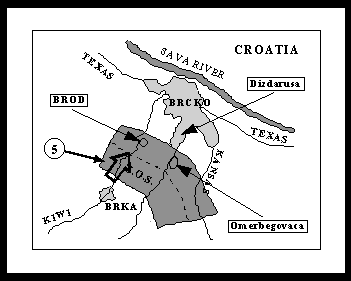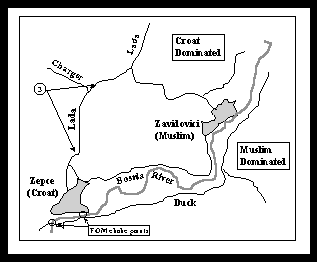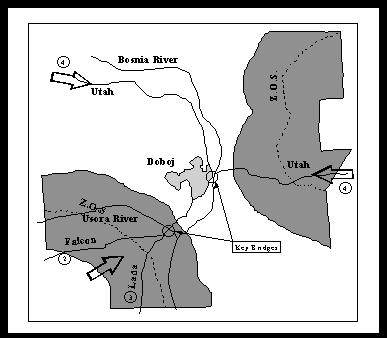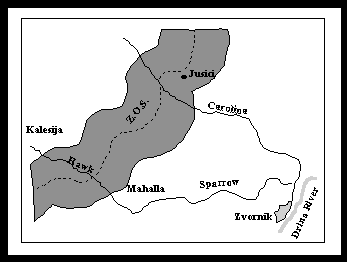APPENDIX B
Election "Hot Spots"
The Multinational Division (North) (MND(N)) Election Cell developed a simple, straightforward, but useful, method for determining the likelihood of any specific area becoming a "hotspot" that might require MND(N) action. This was used during the period leading up to, and immediately following, the Bosnia Herzegovina municipal elections. Under the General Framework Agreement for Peace (GFAP), the Stabilization Force had responsibility for the control of widespread political violence as part of its mission to provide a stable and secure environment for the elections. Thus it became necessary to anticipate those areas where such violence might occur. The Election Cell determined that there were six significant factors that led to the likelihood of political violence or other public disturbance in any given area.
As shown below, these factors were: voter registration that suggested a change in political rule, split opstinas (the equivalent of counties), strategic importance of the area, expectation of movement across Inter-Entity Boundary Lines, any history of inter-ethnic violence and any recent cases of terrorism or other extremist activity. Each of these factors was then weighted according to the perceived relative importance of each factor as an indicator. Those factors judged most important were given a value of two points, while all others were given a value of one point. The determination of these actors and the detection of significant change in them required local knowledge, skill and judgment on the part of the Election Cell. The results, however, were easily displayed and understood.

ELECTION "HOT SPOT" SUMMARIES
The following four opstinas were rated as hot spots by TF Eagle because they had a high potential for election-related violence. The maps include relevant items of interest such as freedom of movement choke points, key bridges, and other approved roads that could be used to access a particular hot spot.
Brcko
 Brcko
was one of the most contested areas in Bosnia-Herzegovina due to its location
in the strategically important Posavina Corridor. Because of the arbitration
process, Brcko had consistently been the focus of the international community.
Brcko was critical because it was the centerpiece of a political battle among
all three major ethnic entities in Bosnia. Note that the Brcko Opstina actually
included "three Brckos"-- one for each area of ethnicity. These were: the Bosniac
Rahic-Brcko and Brka, the Croat Ravne-Brcko, and the Serbian-controlled city
of Brcko. The Serbs had been very defensive about the status of Brcko. Some
local Serbian authorities identified that they would sooner go to war than
hand over Brcko to another entity. Additionally, some Muslims had been rebuilding
their homes in communities (Brod, Dizdarusa and Omerbegovaca) on the Serb side
of the IEBL south of Brcko. Recent resettlement further exacerbated tensions
between the two ethnic groups. When Ambassador Frowick announced that elections
would be held in the Brcko municipality on the RS side only, the decision upset
the Muslims on the Federation side of the Brcko opstina a great deal. This
decision likely intensified the conflict in Brcko.
Brcko
was one of the most contested areas in Bosnia-Herzegovina due to its location
in the strategically important Posavina Corridor. Because of the arbitration
process, Brcko had consistently been the focus of the international community.
Brcko was critical because it was the centerpiece of a political battle among
all three major ethnic entities in Bosnia. Note that the Brcko Opstina actually
included "three Brckos"-- one for each area of ethnicity. These were: the Bosniac
Rahic-Brcko and Brka, the Croat Ravne-Brcko, and the Serbian-controlled city
of Brcko. The Serbs had been very defensive about the status of Brcko. Some
local Serbian authorities identified that they would sooner go to war than
hand over Brcko to another entity. Additionally, some Muslims had been rebuilding
their homes in communities (Brod, Dizdarusa and Omerbegovaca) on the Serb side
of the IEBL south of Brcko. Recent resettlement further exacerbated tensions
between the two ethnic groups. When Ambassador Frowick announced that elections
would be held in the Brcko municipality on the RS side only, the decision upset
the Muslims on the Federation side of the Brcko opstina a great deal. This
decision likely intensified the conflict in Brcko.
Zepce

Zepce
was a Croat pocket in the Muslim-dominated Zenica-Doboj Canton. Prior to the
war, Zepce's population consisted of approximately 47-percent Muslim, 40-percent
Croat, 10-percent Serbian, and 3-percent other ethnic backgrounds. During the
Municipal Election, the population consisted of over 95-percent Croat and less
than 5 percent other minority groups. Historically, violence in Zepce occurred
as the result of either Muslim or Croat groups attempting to exercise their
rights to freedom of movement in the Maglaj Finger. The municipal elections
could have further destabilized an already tense situation in the region.
Doboj
 The
Doboj Opstina couls have been an extremely contentious area during the elections.
The potential for violence was high in Doboj for several reasons. First, Doboj
had strategic value to both the RS and the Federation. The town straddled a
two-kilometer corridor into the Ozren Salient, a large pocket of Serbian territory
southeast of the city. If a non-Serbian entity controlled Doboj, that entity
could effectively cut off the Serbian pocket from the remainder of the RS.
Prior to the war, the population of Doboj consisted of approximately 40-percent
Muslim, 39-percent Serbian, 13-percent Croatian, and 8-percent other ethnic
backgrounds. At the time of the election, the population consisted of over
90-percent Serb and less than 10-percent other minority groups. The majority
of the 21,820 Muslim residents of East Doboj were from Doboj and wished to
return to their original homes. Before the elections, Serb crowds from Doboj
confronted Muslims trying to cross the Usora bridge into town and prevented
their freedom of movement.
The
Doboj Opstina couls have been an extremely contentious area during the elections.
The potential for violence was high in Doboj for several reasons. First, Doboj
had strategic value to both the RS and the Federation. The town straddled a
two-kilometer corridor into the Ozren Salient, a large pocket of Serbian territory
southeast of the city. If a non-Serbian entity controlled Doboj, that entity
could effectively cut off the Serbian pocket from the remainder of the RS.
Prior to the war, the population of Doboj consisted of approximately 40-percent
Muslim, 39-percent Serbian, 13-percent Croatian, and 8-percent other ethnic
backgrounds. At the time of the election, the population consisted of over
90-percent Serb and less than 10-percent other minority groups. The majority
of the 21,820 Muslim residents of East Doboj were from Doboj and wished to
return to their original homes. Before the elections, Serb crowds from Doboj
confronted Muslims trying to cross the Usora bridge into town and prevented
their freedom of movement.
Zvornik
 The
potential for violence in the Zvornik Opstina was high during the Municipal
Elections. Pre-war statistics indicated the Zvornik area was predominantly
Muslim. After the war, the Serbs became the dominant ethnic group. Many of
Zvornik's displaced persons (DPs) lived in the Tuzla Valley and were in an
excellent position to cross the IEBL to vote in the Zvornik opstina on election
day. Many DPs crossed through Kalesija into Zvornik. Estimates of Zvornik bound
voters ranged from 300-1,300 personnel. It was thought that Muslims returning
to Mahala or Jusici carrying weapons would force further confrontations with
the Serb Police. There was a Zvornik Special Police Detachment (SPD) that could
respond to incidents during the municipal elections. This SPD had approval
to serve as a QRF using helicopter support to move to areas of civil unrest.
The
potential for violence in the Zvornik Opstina was high during the Municipal
Elections. Pre-war statistics indicated the Zvornik area was predominantly
Muslim. After the war, the Serbs became the dominant ethnic group. Many of
Zvornik's displaced persons (DPs) lived in the Tuzla Valley and were in an
excellent position to cross the IEBL to vote in the Zvornik opstina on election
day. Many DPs crossed through Kalesija into Zvornik. Estimates of Zvornik bound
voters ranged from 300-1,300 personnel. It was thought that Muslims returning
to Mahala or Jusici carrying weapons would force further confrontations with
the Serb Police. There was a Zvornik Special Police Detachment (SPD) that could
respond to incidents during the municipal elections. This SPD had approval
to serve as a QRF using helicopter support to move to areas of civil unrest.
|
NEWSLETTER
|
| Join the GlobalSecurity.org mailing list |
|
|
|

